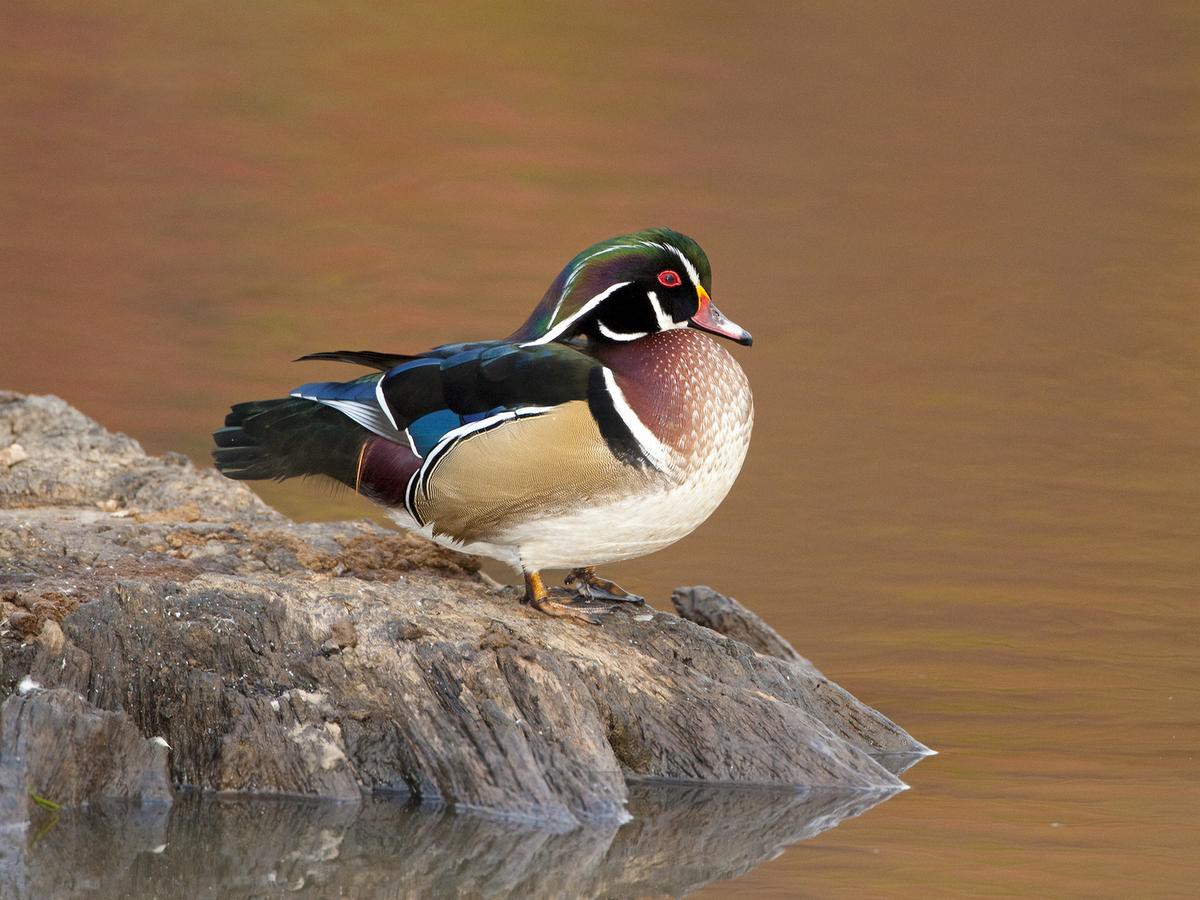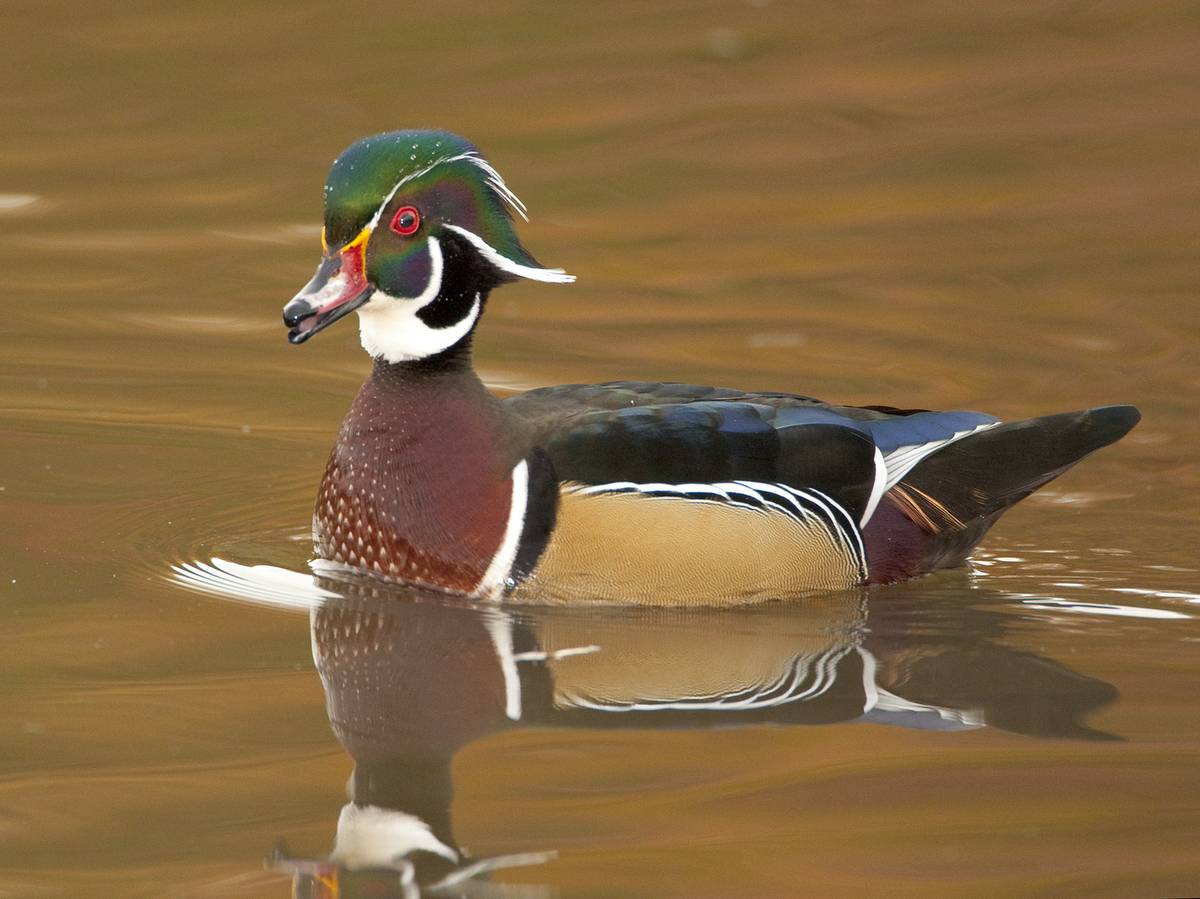Most anyone who has perused a field guide knows the Wood Duck – perhaps the most visually distinctive and striking bird in North America. Indeed, even nonbirders may recognize the species just from having seen its iconic image in popular art, as on a hotel wall or a coffee mug.
But despite the outward flamboyance and familiarity of the species, most people haven’t ever really watched Wood Ducks up close, nor gotten to know them. They are never tame like urban Mallards and Canada Geese. They are seldom abundant and conspicuous, like goldeneyes, scaup, and mergansers on open water in migration. Instead, Wood Ducks are discreet and easily overlooked, but full of secrets and hidden angles, like the woods and sheltering wetlands where they live.
Adult male Wood Ducks are unmistakable, with bright red eyes and bill contrasting with a white-striped green face, white throat and deeply russet breast. Adult female Wood Ducks have muted brown-gray plumage, with a white patch around each eye. Juveniles resemble adult females. Even in silhouette, Wood Ducks strike a profile unique among North American waterfowl, given their small size, short bills and crests that taper tidily to a point at the back of the head.
Despite their bold appearance, Wood Ducks are usually much more difficult to see than other waterfowl. Wood Ducks most often reveal their presence when females take flight, voicing a husky hweek-hweek-hweek! Males sound quite different, perching on high branches and issuing a rising zzzzzzzzzeeeb! like a very long fine-toothed zipper being closed with a flourish.
Wood Ducks are migratory, appearing throughout central and western New York around the beginning of March and departing by mid-November. They breed in various wooded habitats, preferring mature trees near wetlands with a mix of open water and cover from vegetation, including downed timber.
In the early 20th century, Wood Ducks were thought to be seriously endangered because of unrestricted hunting and habitat loss. Then the federal Migratory Bird Treaty Act of 1918 banned the hunting of ducks for sale. In subsequent decades, most states established bag limits and seasonal restrictions on recreational hunting. These measures have led to a strong recovery. Increased beaver populations may also help explain the rise in Wood Duck populations, as flooded woods constitute ideal habitat. Wood Duck numbers are now stable or rising throughout their range, even though the species remains a very popular target of hunters – indeed, the most-hunted duck species in the Atlantic Flyway.
Wood Ducks have a broad diet, including seeds, aquatic grasses, fruit, and both terrestrial and aquatic invertebrates. If food is scarce in wetlands, Wood Ducks sometimes forage for acorns in woodlands, or for grain or soybeans in harvested fields.
Wood Ducks nest in cavities. They prefer natural holes, especially those formed where large branches have broken off from tree trunks, from near ground level up to 60 feet. They also take readily to human-made boxes placed on poles or tree trunks at the edges of wetlands.
The female tends the nest and young without assistance from her mate. She lines the nest with down that she plucks from her own breast and belly. Wood Ducks are unusually prolific egg-layers, with clutch sizes usually ranging between 9 and 12 eggs. Moreover, female Wood Ducks often lay eggs in each other’s nests. Hooded Mergansers also often parasitize Wood Duck nests in this way. In such cases, one can find between 17 and 29 eggs in one Wood Duck nest.
About 24 hours after the young hatch, the mother inspects the area around the nest. If she finds it safe, she positions herself directly under the nest hole and vocalizes softly. The tiny yellow ducklings step to the lip of the hole and plummet to the ground or water, flapping their stubby wings and relying on their fuzzy plumage and wide feet to create enough friction to brake their descent. They usually land on their feet, unfazed by the impact, even from a height of five or six stories. Sometimes, if an intervening twig upsets the duckling’s fall, it can land awkwardly, but even then, it remains stunned only momentarily. Then the mother leads her troop of day-old ducklings to open water. When suitable nest cavities right next to water are unavailable, this journey may involve a walk of up to 1.5 miles, fraught with risk of predation by snakes, raccoons, mink, owls, and hawks.
And so, far more than just a pretty picture, the Wood Duck is the embodiment of the wonders of ecology and evolution, the fragility of life amid natural and human-created perils, and the enduring value of sound conservation policy. Take the time this spring to go out to our woods and wetlands, listen and look, and maybe Wood Ducks might share some of their secrets with you.



